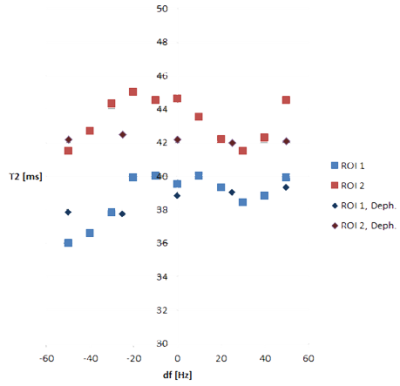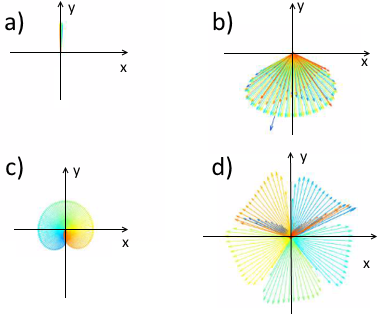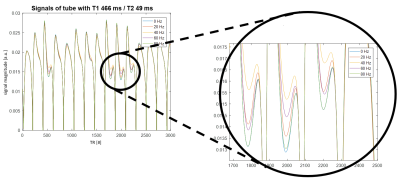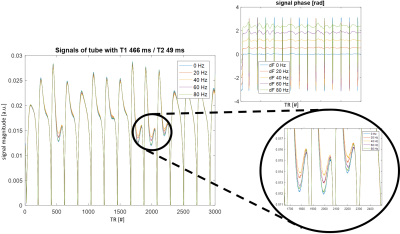4232
Description of the off-resonance dependency in slice-selective FISP MRF1Siemens Healthcare GmbH, Erlangen, Germany, 2Max Schaldach-Stiftungsprofessur für Biomedizinische Technik, Friedrich-Alexander-Universität Erlangen-Nürnberg, Erlangen, Germany, 3Georg-August-Universität Göttingen, Göttingen, Germany, 4Biomedical Engineering, Case Western Reserve University, Cleveland, OH, United States
Synopsis
In Magnetic Resonance Fingerprinting (MRF), quantitative parameter maps are generated by matching pseudo randomly generated MR signals with a precalculated dictionary. A common implementation of MRF is based on an unbalanced SSFP (FISP) sequence in combination with a slice-selective excitation. In this work, we demonstrate its sensitivity to off-resonances in specific configurations, investigate the underlying spin physics and derive according mitigation approaches.
Purpose
Magnetic Resonance Fingerprinting (MRF)1 is a new technique that promises multi-parametric, quantitative MRI. A common MRF implementation is based on a steady-state free precession (SSFP, FISP) sequence2. Here, an unbalanced SSFP sequence is used with varying TR and flip angle. In the original paper, only T1 and T2 were included in the signal model. Over the past years, several papers have shown a B1+ dependency in FISP MRF and how it can be addressed3,4. B0 has not been identified as a parameter that influences results since the spoiling at the end of each TR is supposed to minimize B0-dependent signal differences.
We show that in certain configurations a dependency of FISP-MRF-generated parameter maps on B0 can be observed in experiments5. An unbalanced slice-selective gradient is not sufficient for mitigating the B0 dependency, and a dephasing gradient before each RF pulse cannot be left out. In this work, we present an explanation for this effect and show how the effect changes with different dephasing gradient moments.
Methods
We used a prototype implementation of the FISP-MRF method2 with a spiral acquisition scheme (undersampling factor 48, field-of-view 300 mm, resolution 1.2 mm, RF pulses with time-bandwidth-product of 8). The spirals were rotated by 82.5° from TR to TR6,7. A B1+ correction based on a prescan8 is employed.
Measurements with varying B0 field offsets were performed on a human brain without a dephasing gradient before each RF pulse and with a dephasing gradient corresponding to a dephasing moment of 8 pi over the measured slice.
For the theoretical investigation a MRF signal was simulated with different dephasing moments before each RF pulse. The behavior of the spins across the slice was analyzed and related to a B0 dependency. Measurements on tubes filled with agarose and known T1/T2 combinations were performed with 1D spatially encoded projection images without undersampling artifacts. These measurements were performed with different dephasing moments before each RF pulse and compared to the corresponding simulations.
Results
Figure 1 displays T2 values in two ROIs placed in white matter regions of a human brain, from MRF experiments without an additional dephaser and with an additional dephasing moment of 8pi with global B0 offsets. Considerably higher deviations can be observed without an additional dephasing moment.
Figure 2 shows the transversal components of simulated spin ensembles across the slice, with and without employing an additional dephasing moment. Two time points are shown; after the first RF pulse and after about 500 RF pulses. The behavior of the spin ensembles is considerably different. The mean signal of the spin ensemble is not 0 in the case without additional dephaser.
Figure 3 shows a simulated signal evolution without an additional dephaser for different off-resonances and as well as a zoomed version. Figure 4 displays the corresponding measured signals using the projection method. Additionally, also a zoomed version and the signal phases are shown. The effect of off-resonance is similar in simulation and measurement. The signals are spread out for different off-resonances. A B0 dependency with a peridocity of 1/TR=80Hz can be observed.
Figure 5 shows the mean relative deviation of T1/T2 values over 5 different sample tubes, measured using the projection method and different dephasing gradient moments at different off-resonances. A trend to lower deviations with higher additional dephasing moment can be seen.
Discussion
A B0 dependency in slice-selective FISP-MRF can be explained with the presented results. The spin ensemble is not fully dephased before the onset of the RF pulse if no additional dephasing gradient is used. This leads to a TrueFISP-like B0 dependency that is shown in basic experiments and simulations. Since a TR of approximately 13 ms is used, the signal with an off-resonance of 40 Hz differs most from the one with 0Hz, while the signals from 0 and 80 Hz are almost the same.
To mitigate this TrueFISP-like off-resonance dependency, a sufficient spin dephasing before the onset of the RF pulse has to be ensured. An unbalanced slice-selective gradient is not sufficient since B1 is already applied at the beginning of the slice-selective gradient while spins are not yet dephased. If all B1 would be instantaneously applied at the middle of the slice-selective gradient, no additional dephasing moment would be needed.
With different dephasing moments, the B0 dependency can be mitigated. A dephasing moment of 3.5 pi has a similar effect as a dephasing moment of 8 pi in this basic study.
Conclusion
We identified the physical concepts behind the off-resonance sensitivity in slice-selective FISP MRF and showed how this effect can be minimized.Acknowledgements
No acknowledgement found.References
1 Ma D. et al, Magnetic resonance fingerprinting. Nature 2013;
2 Jiang Y. et al, MR fingerprinting using fast imaging with steady state precession (FISP) with spiral readout. MRM 2015;
3 Buonincontri G. et al, MR fingerprinting with simultaneous B1 estimation. MRM 2016;
4 Cloos MA. et al, Multiparametric imaging with heterogeneous radiofrequency fields. Nat. Commun. 2016;
5 Guzek, B. et al, Influence of Off-resonance on FISP Magnetic Resonance Fingerprinting (FISP-MRF). ISMRM 2018, submitted;
6 Pfeuffer, J. et al, Mitigation of Spiral Undersampling Artifacts in Magnetic Resonance Fingerprinting (MRF) by Adapted Interleaf Reordering. ISMRM 2017;
7 Körzdörfer, G. et al, Spatial biases in Magnetic Resonance Fingerprinting parameter maps arising from undersampling patterns. ISMRM 2017;
8 Chung S. et al., Rapid B1+ mapping using a preconditioning RF pulse with TurboFLASH readout, MRM 2010;
Figures




